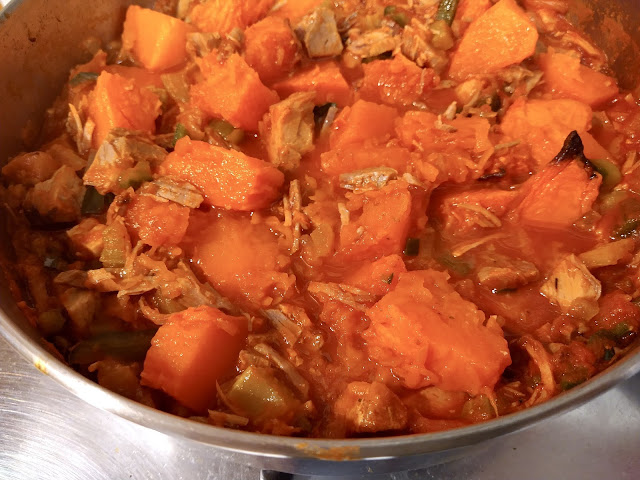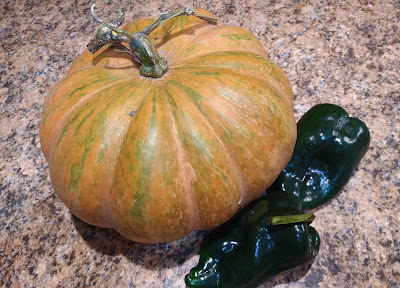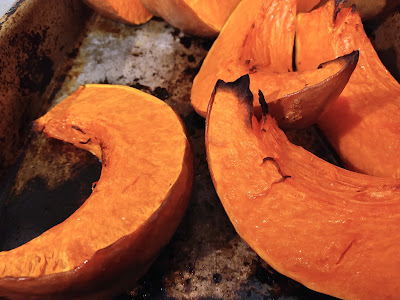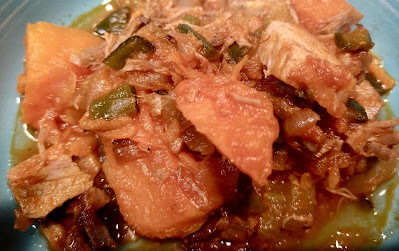
Recipe: Roast pumpkin-pork stew with poblano pepper

|

A heritage pumpkin and poblano peppers are the base of the
Oaxacan-inspired stew.
|
Pumpkin pairs well with pork; roast pumpkin and roast pork team up even better.
Warmed by poblano pepper and cumin, this Oaxacan-inspired stew makes use of both: Chunks of oven-roasted pumpkin and leftover pork roast. Serve alone or over rice or polenta.
For this recipe, the pumpkin can be roasted up to two days in advance. Roasting keeps the chunks firmer than steaming, so the pumpkin doesn’t turn to mush in the stew.
How to roast pumpkin: Wash and pat dry pumpkin. Cut pumpkin into wedges. Scoop out seeds. Preheat the oven to 400 degrees F. Brush cut surfaces of pumpkin with olive oil. Season with salt and pepper. Arrange wedges in a large baking pan or on a rimmed cookie sheet with cut sides up. Bake at 400 degrees until the pumpkin is fork-tender, about 40 minutes. Let cool for 10 minutes. Peel and cube.
 |
| Roasted pumpkin won't turn to mush in the stew. |
Roast pumpkin-pork stew
Makes 4 servings
Ingredients:
2 cups roast pumpkin, cubed
2 cups cooked pork roast, cubed
2 tablespoons olive oil
1 cup onion, diced
2 celery stalks, chopped
1 clove garlic, minced
1/3 cup poblano pepper, seeded and chopped
¼ cup white wine
½ cup chicken or vegetable broth
1 cup tomato sauce
1 teaspoon cumin
Salt and pepper to taste
Instructions:
Cube roast pumpkin and cooked pork. Set aside.
In a large skillet, heat olive oil. Over medium heat, sauté onions, celery, garlic and poblano pepper until soft. Add pork chunks to pan and sauté lightly, about 2 to 3 minutes.

|
Add white wine to deglaze the pan. Add tomato sauce, chicken broth and cumin. Cover the pan and reduce heat. Let simmer, about 5 to 10 minutes, stirring occasionally. Season sauce with salt and pepper to taste.
Add pumpkin chunks to the pan and re-cover the pan. Let stew simmer for another 5 minutes, stirring gently. (Don’t mash the pumpkin.) Adjust seasoning.
Serve warm.
Comments
0 comments have been posted.Sacramento Digs Gardening to your inbox.
Sites We Like
Garden Checklist for week of July 21
Your garden needs you!
* Keep your vegetable garden watered, mulched and weeded. Water before 8 a.m. to reduce the chance of fungal infection and to conserve moisture.
* Feed vegetable plants bone meal, rock phosphate or other fertilizers high in phosphate to stimulate more blooms and fruiting. (But wait until daily high temperatures drop out of the 100s.)
* Don’t let tomatoes wilt or dry out completely. Give tomatoes a deep watering two to three times a week.
* Harvest vegetables promptly to encourage plants to produce more. Squash especially tends to grow rapidly in hot weather. Keep an eye on zucchini.
* Pinch back chrysanthemums for bushy plants and more flowers in September.
* Remove spent flowers from roses, daylilies and other bloomers as they finish flowering.
* Pinch off blooms from basil so the plant will grow more leaves.
* Cut back lavender after flowering to promote a second bloom.
* It's not too late to add a splash of color. Plant petunias, snapdragons, zinnias and marigolds.
* From seed, plant corn, pumpkins, radishes, winter squash and sunflowers.